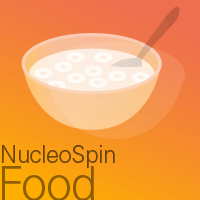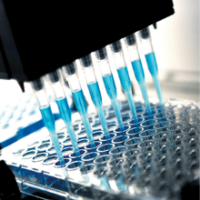| Technology | Magnetic bead technology |
| Format | Highly reactive superparamagnetic beads |
| Processing | Manual or automated |
| Sample material | <200 mg food or feed |
| Fragment size | 300 bp—approx. 50 kb |
| Typical yield | 0.1–10 μg |
| A260/A280 | 1.6–1.9 |
| Elution volume | 50–200 µl |
| Preparation time | 120 min/96 preps (excluding lysis) |
| Binding capacity | 0.4 µg/µl beads |
Product overview
NucleoMag DNA Food
NucleoMag DNA Food is designed for the rapid manual and automated preparation of DNA from small-scale food or feed samples and can be used to detect the presence of GMO DNA or animal components in these samples.
- Provided reagents can purify up to 200 mg of material with a typical yield of 0.1–10 μg of DNA (depending on individual samples)
- Eluted DNA is ready for immediate use in subsequent reactions including real-time PCR, GMO detection, etc.
- Designed for use with the NucleoMag SEP magnetic separator plate or other equivalent magnetic separation system
- Time for the manual preparation of 96 samples is about 2 hours
- Compatible with common automated liquid handling instruments and magnetic separators
At-a-glance
Protocol

Figure 1. Summary of protocol. The procedure is based on the reversible adsorption of nucleic acids to paramagnetic beads under specialized buffer conditions. Sample lysis is achieved by incubation of samples with Proteinase K at 65 °C. Lysis mixtures are cleared by centrifugation or filtration in order to remove contaminants and residual cellular debris. Nucleic acids are then bound to the paramagnetic beads via addition of Binding Buffer CB and the NucleoMag B-Beads to the cleared lysate. After magnetic separation, the paramagnetic beads are washed to remove contaminants and salts using Wash Buffers CMW, CQW, and 80% ethanol. Residual ethanol from previous wash steps is removed by air drying. Next, highly purified DNA is eluted with low-salt Elution Buffer (CE) and can be used directly in downstream applications. The NucleoMag DNA Food kit can either be used manually or automated on standard liquid handling instruments and automated magnetic separators.
DNA from many types of food

Figure 2. Effective isolation of DNA from various food samples. Sample homogenization and lysis were performed manually, whereas DNA isolation was automated using a KingFisher Flex. DNA presence within the eluates was determined using qPCR.
| Category | Tested sample material |
| Raw, vegetable origin |
Carrot, potato, soy, maize, canola, linseed, oat, rice, wheat, sunflower seed, grape, seeds (tomato, cucumber, eggplant, melon, pepper), animal food |
| Raw, animal origin |
Venison, pork |
| Processed, vegetable origin |
Agave nectar, oatmeal |
| Processed, animal origin |
Milk, cheese, honey, salami, meat sausage, liver sausage |
| Complex processed, vegetable origin | Vegetable broth, chips, pastry, cocoa, fried onions, tea, spices, tofu, juice, cereal bar, bread |
| Complex processed, animal origin | Tiramisu, fruit gum, licorice, chocolate, Nutella, noodles, baby food, oil, drippings |
Table I. Overview of different sample types that have been successfully tested. Following DNA extraction with the NucleoMag DNA Food kit, the presence of DNA was tested by either qPCR or via agarose gel electrophoresis.
Superior DNA yield

Figure 3. Higher DNA yield with NucleoMag DNA Food versus a leading competitor. DNA from a variety of food sources was isolated using either the NucleoMag DNA Food (MN) or a competitor's kit (P) and DNA was detected using qPCR. The NucleoMag DNA Food kit consistently demonstrated lower Ct values than the competitor's kit, indicating a superior DNA yield.
Related Products
Takara Bio USA, Inc.
United States/Canada: +1.800.662.2566 • Asia Pacific: +1.650.919.7300 • Europe: +33.(0)1.3904.6880 • Japan: +81.(0)77.565.6999
FOR RESEARCH USE ONLY. NOT FOR USE IN DIAGNOSTIC PROCEDURES. © 2025 Takara Bio Inc. All Rights Reserved. All trademarks are the property of Takara Bio Inc. or its affiliate(s) in the U.S. and/or other countries or their respective owners. Certain trademarks may not be registered in all jurisdictions. Additional product, intellectual property, and restricted use information is available at takarabio.com.






